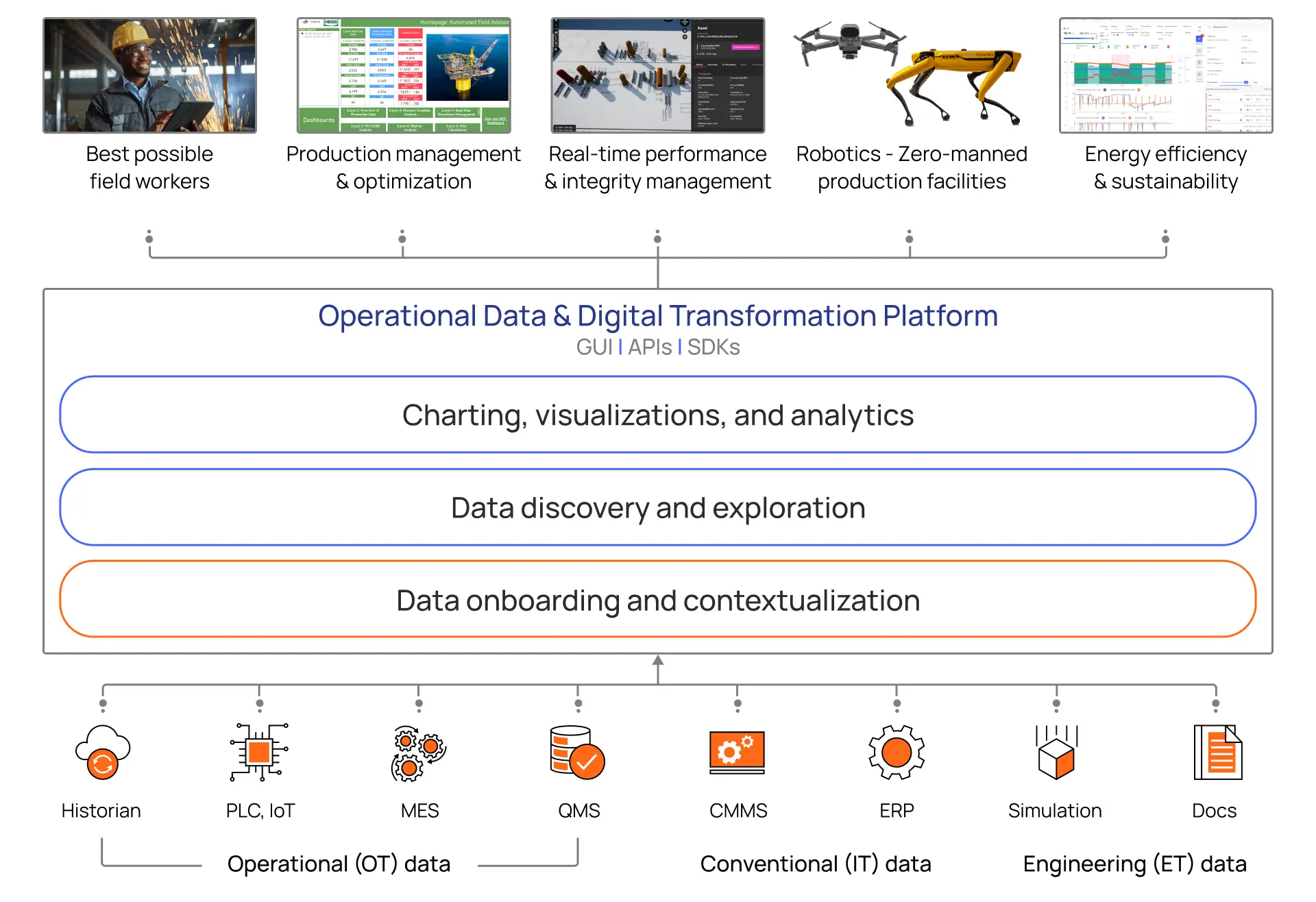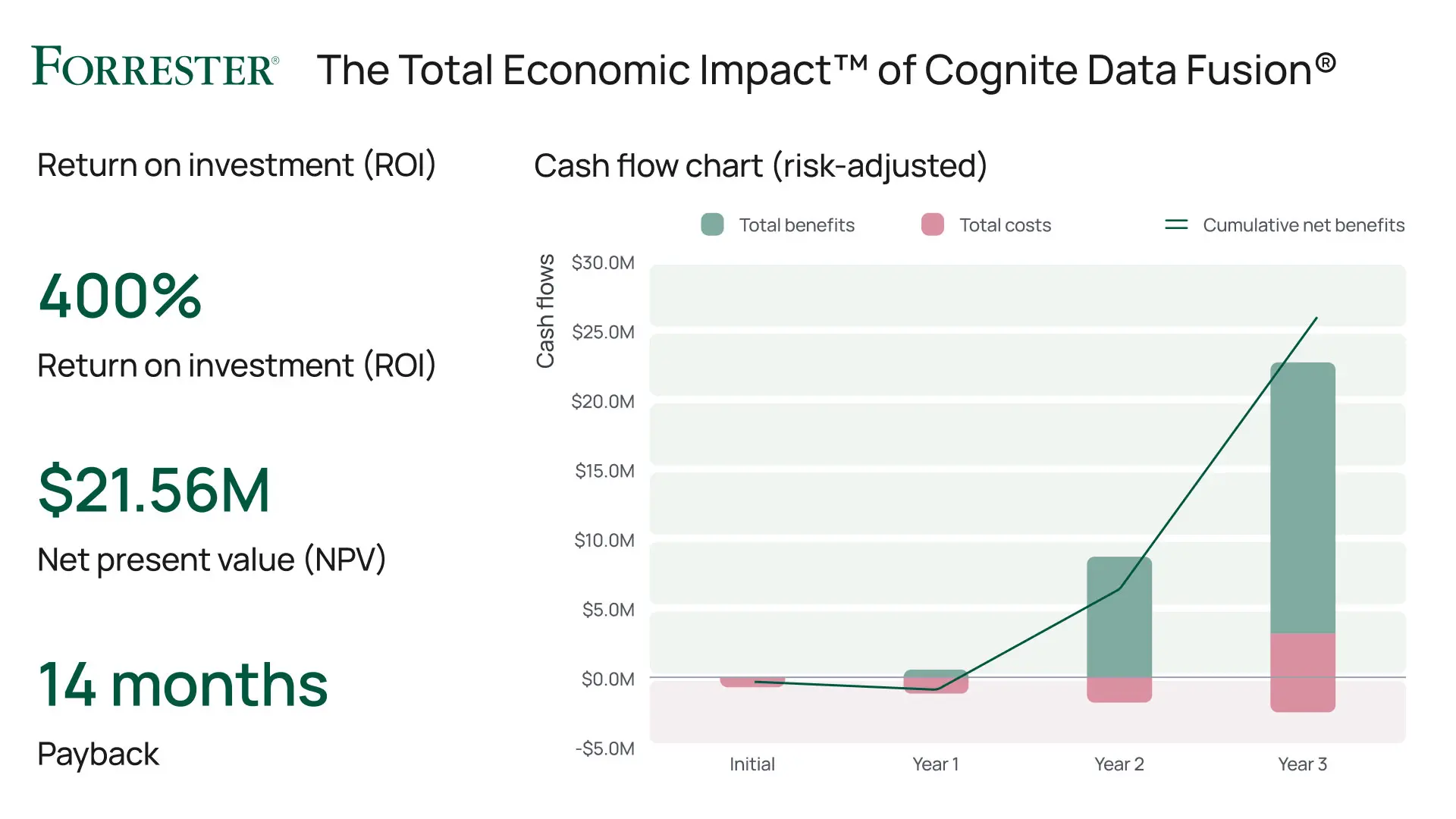Many of us know of one or more organizations reflecting and reviewing their DIY Data & Digital Platform projects – trying hard to quantify business value delivered, as well as increasing confidence in value that is to be delivered in 2023.

Though many had convinced themselves a large budget and an equally large team needed years to meet the requirements of delivering a new Data & Digital Platform, those years of investment are now sunk costs, and the promised digital transformation yield remains hard to substantiate. Fact of the matter is, actual business usage remains at a minuscule level, often limited to one lighthouse site, with very few active business users.
The dual challenge of complex industrial data management and domain expertise templatizing required to address use cases at scale — across sites and across asset performance management disciplines — have been learned the hard way. Gartner’s[1] words of caution from early 2021 'This isn’t just another software development project!' are being felt.On top, clunky and disjointed user experience of technical back-end first designed platforms are not exactly making SMEs fight for self-service access to the new platforms…
Let's review the seven myths about DIY platforms and reflect if it is indeed time for change?
Spoiler: the logical conclusion is that you don’t need to DIY because of 1-7. Choosing one or selecting a few SaaS partners, or including SaaS into your DIY platform reference architecture (see reference architecture below), should definitely be on your 2023 agenda — especially when putting business value first, and thus banking on 5-7 on the list.

Reference architecture for going from DIY to DIY Accelerated

DIY is cheaper
Talking about cost alone is of course nonsense. Investing $100K and not getting any return is a poor investment, whilst investing $2M for a $8M ROI is a solid financial investment.
Cost is also not the license cost paid to cloud and/or SaaS partners, but the Total Cost of Ownership (TCO) including the ‘mortar’ (people) needed to put together and maintain the Data & Digital Platform. Unlike with normal business SaaS, the ongoing cost of the ‘mortar’ often far exceeds the software license cost for DIY platforms. This ‘mortar’ is of course part of the true cost.
It is not hard to find very large (100+ FTEs of ‘mortar’ alone) DIY platforms across industries, making the cost side rather high. Are the economies 'cheaper' with commercial SaaS that does not require similarly persistently high volumes of ‘mortar’? This is very very unlikely. So unlikely in fact, that finding reasons to not choose SaaS has always focused more on 2-7 on the list. In the more austere times ahead, this alone should speak volumes.
What about the business value delivered by DIY? Would you be reading this if that value was a strong triple-digit percentage?. As for Cognite Data Fusion® customer value, an independent study by Forrester recently concluded 400% ROI delivered.


DIY is the only way to avoid vendor lock-in
One of the most ironic arguments around is that by going all-in with one cloud and DIYing everything using that cloud’s proprietary services (as multi-cloud DIY is exponentially harder), this platform strategy will protect against vendor lock-in.
The truth is, your enterprise is already multi-cloud, and will be more so going forward. Cisco Systems Inc.’s 2022 Global Hybrid Cloud Trends survey found that 82% of IT leaders have adopted a hybrid cloud while just 8% use only a single public cloud platform.
Same applies to your SaaS choices. Working with select specialists gives you access to relative strengths of different partners. It allows you to compensate for lack of a specific capability by one, with that of another. It allows you to maintain your flexibility of choice. If categorically avoids waking up locked in to one costly, lower performance solution with a very high TCO.
Openness, focus on industry standards for data exchange and data models, and placing partner ecosystems — including frenemy ecosystems — at the center of customer value delivery are not unique to clouds, these are normative business hygiene for all of 2020s enterprise SaaS. Choosing SaaS to get to business value fast does not result in lock-in. Finding yourself with a high TCO solution that does not meet business needs on the other hand is lock-in of the worst kind.
If, of course, you fear getting locked into a SaaS vendor because your business users love using their solution over DIY alternatives, then you should jump to 5-7.

DIY is necessary to differentiate
Anchored in competitive strategy, the thesis that to outperform peers, one has to be differentiated is of course true, yet for manufacturing or energy companies to pursue meaningful differentiation by building proprietary Data & Digital Platforms is missing the forest for the trees.
Building a proprietary Data & Digital Platform is only meaningfully differentiating if it has a positive impact on the customer experience - in this case, how easily can SMEs use the platform to create business value. For anything technology related, this more and more means positive product user experience (UX) differentiation, not technical features. Getting DIY user experience (UX) to stand out above SaaS alternatives who are able to learn and iterate based on feedback from hundreds of customers – whilst your teams learn only from your users – is a moonshot.
The world is full of highly differentiating industrials using the same ERP (SAP) and the same CRM (Salesforce) for example. In fact, by leaving the tools of the trade to specialists (SaaS partners who only exist to provide these solutions), you can differentiate on what your customers actually value: on your customer service, your distribution, your ESG, your business model, and beyond. As for cost efficiency as a differentiator, go back to 1 above.

DIY is the only enterprise-grade path
Enterprise SaaS is every bit as enterprise-grade as the first-party public cloud services used to develop a custom made Data & Digital Platform. The only difference is that whilst enterprise SaaS comes with comprehensive SLA and premium support options, with DIY, you are responsible for your own SLA and support. May not sound like a seismic difference in the early phase of a DIY journey, yet when it comes to supporting thousands of users, having a strong user community and documentation – all table stakes with enterprise SaaS – warrant serious consideration. Enterprise grade means enterprise scale usage ready.
Moreover, enterprise SaaS comes with coherent, well researched, painstakingly tested and iterated, business-user-persona-based UX. Whilst perhaps not yet the first on the enterprise-grade checklist, cutting-edge 'Maverick' CIOs already place UX first for good reason.
And of course, all enterprise SaaS comes with enterprise grade security. With all likelihood, your enterprise's customer data as well as employee data is already on an enterprise SaaS product – are your equipment time series and events really more confidential?


DIY is what innovators do
Being innovative means doing things differently or doing things that have never been done before. Innovators drive business impact and operational change. Innovators challenge and change the status quo. Innovators think differently. Innovators take calculated risks to ensure their business is on the right side of history.
For Data & Digital Platforms, innovators are not repeating pre-cloud, pre-SaaS era, bespoke software development practices, but instead, are turning their sights to the growing number of readily available SaaS industry cloud platforms, that according to Gartner[2]:
- are designed to meet the specific needs of vertical industry segments inadequately served by generic solutions;
- turn a cloud platform into a business platform;
- pointedly appeal to business consumers beyond the early users of cloud infrastructure and platform technologies.
- add value by using innovative technologies and approaches, such as packaged business capabilities, industry-aware data fabrics and composable tooling to go beyond traditional cloud and create added value.
Gartner expects that by 2027, enterprises will use industry cloud platforms to accelerate more than 50% of their critical business initiatives, whereas in 2021, it was less than 10%.
For business value obsessed technology leaders, this enterprise SaaS path is innovation.

DIY gives me job security
The best means of creating job security and establishing value for your department and your team is to create business impact aligned with your company's strategic priorities and values. Delivering real business value to your business operations is the most direct, measurable, and visible way of doing so.
It is also worth noting that your business operations do not care what the brand of the tooling is. They only care that it makes their day-to-day lives easier, allows them to have better situational awareness on events in real-time, and to make better business decisions. They really do not care if it is DIY built or SaaS or hybrid. They do care that it is fit for purpose, easy-to-use, and that it makes their life easier, not more difficult.
In different times, starting a promising, multi-year, 3-figure ($M) strategic DIY platform project was aspirational. Today, in different times and with the majority of those 3-figures spent without much ROI to show for, focusing on here-and-now value to business is the best job security plan there is.

DIY allows me to play a strategic role
Meeting business needs today – and anticipating business needs of tomorrow – is strategic. Finding agile solutions to business needs that deliver value quickly, are easy for business users to adopt and scale; are open, interoperable, and extendable; and are flexible to onboard, maintain, and offboard if needed is strategic.
Focusing on customer experience is strategic. Being open to new ideas, and being the one to introduce innovation (see industry cloud platforms in 5. above) is strategic.
With all likelihood, your company is not turning into a software platform company, but is and will remain an energy or manufacturing company. Continuing to build and maintain the behind-the-scenes, bottom-of-the-stack platform services on which to build business value and differentiation is a necessary evil. Strategic it is not.
So turn a new clean page and think strategically about what would be best for your business regardless of sunk costs. That too is strategic.
The only way to conclude this article is by returning to the spoiler. After reviewing and reflecting on the 7 myths about DIY Platforms that we have come across over the past years, it is time we put business value first.
One logical conclusion
You don’t need to DIY because of 1-7. Choosing one or selecting a few SaaS partners, or including SaaS into your DIY Platform reference architecture (see reference architecture below), should definitely be on your 2023 agenda.

Reference architecture for going from DIY to DIY Accelerated
[1] Gartner: How to Build a Digital Business Technology Platform, 2021
[2] Gartner, What Are Industry Cloud Platforms?, September 21, 2022


